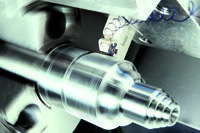There’s more to the choice between laydown and on-edge threading tools than personal preference
by Kip Hanson
I admit, I’m a fan of on-edge or “Top Notch” style threading inserts. They’re simple to use, cost effective, and since a single insert can cut any number of threads, are quite flexible. I also admit that, because that was the only indexable insert available to us when I began single-point threading nearly four decades ago, and because they beat the heck out of brazed or hand-ground tool bits (yes, we really used those), of course that’s where my mind goes when someone mentions single pointing.
A great deal has changed since then, and machinists have many more choices available to them now than I did back in the high-interest rate, high-inflation 80s. One such option is a laydown threading insert. Our shop’s friendly cutting tool representative began pushing the first iterations of this now standard threading tool back when toolmaker Carboloy and 883 carbide were “the other guys,” but I wanted nothing to do with those funny looking inserts.
 Watch the flanks
Watch the flanks
I should have listened to him. “The Top Notch system was initially designed for grooving applications,” says Nathan Preiss, product manager at Ingersoll Cutting Tool Co. “The concern with using it for threading is that every thread has a specific helix angle, which changes based on the diameter and pitch of the application. But Top Notch has a neutral plane, so it doesn’t accommodate the thread’s resultant helix angle very well. The insert therefore has a tendency to rub on one side more than the other, causing uneven flank wear, chatter, and galling of the threads.”
According to Preiss, Ingersoll’s T-thread laydown-style threading system eliminates that problem. By using a replaceable anvil beneath the insert, users are able to adjust its “tilt” angle, matching both sides of the insert to the actual helix angle of the application. “It’s similar to aligning the wheels on your car,” he explains. “Instead of pulling to the left or right, you achieve equal tool pressure on both sides. Tool life is improved, as is thread quality.”
 Too many choices
Too many choices
To be fair, Top Notch style threaders remain alive and well. Each of the manufacturers participating in this article offer a version of on-edge threading insert, some remarkably similar to the original. For example, Ingersoll offers its four-sided Gold-Flex insert. Sandvik Coromant has the CoroCut XS and Top-Lok systems. And Iscar Tools offers the on-edge style Deca-IQ-Thread, Penta-Cut, Notch-Grip, and others. In fact, there are so many different styles, geometries, and grades of single point threading inserts out there that many on the shop floor might be left scratching their heads and wishing for simpler times.
These include internal and external threading, threading on Swiss style lathes, left and right hand threading, topping vs. non-topping inserts, not to mention a universe of different thread forms and materials…unfortunately, there is no one size fits all solution.
“There are a lot of threading tool options because there are so many different threading requirements,” says Ashok Guruswamy, product manager for Grip/Turn products at Iscar Tools Canada. “Despite this, many of our customers are using laydown style inserts. This platform offers the greatest selection of thread standards, grades and geometries.”
Beyond price
Insert selection often comes down to cost. A laydown style insert with three cutting edges sells for roughly the same price as a double-sided, on-edge insert. However, some newer styles of on-edge insert have up to ten cutting edges, making them more economical compared to laydowns.
Still, Guruswamy suggests that cutting tools should be selected on their merits rather than their price tag. “Because of the way our Deca-IQ and Penta-Cut on-edge inserts are secured in the pocket, the quality of thread and insert tool life is substantially increased.”
Kevin Burton, parting and grooving specialist for Sandvik Coromant Canada Inc., agrees that there’s far more to single-point threading than the price of the insert, its geometry, and how it’s oriented within the toolholder. There’s also rigidity.
“As they enter and then exit the thread, inserts are subjected to large, sudden variations in both the magnitude and direction of cutting forces,” he says. “This leads to micro-movement of the insert within the pocket, deforming the seat and further escalating the instability. The movement also has a negative effect on tool life, more so than the actual tool wear.”
Hang on tight
The solution, says Burton, is to prevent that movement in the first place. “This is why we developed the iLock. It simultaneously improves the toolholder’s insert locating and clamping capabilities, producing new levels of security and tool life.”
So what’s the best choice? For the average job shop that cuts a wide variety of threads, or that cuts just a few threads infrequently, it probably doesn’t matter. Each of the systems listed here will do a fine job of general purpose threading. But for those cutting thousands of threaded parts annually, that routinely cut challenging aerospace materials, or that cut very large or very deep threads, you need the very best threading system available.
This might mean setting aside your old school bias (as I eventually did). Abandon any concerns over tool crib inventory bloat or the headaches that come with trying new tools. Scope out your available tooling options, make time for testing and documentation, and try on some new single-point threading technology for size. Your profit margin will thank you. SMT
